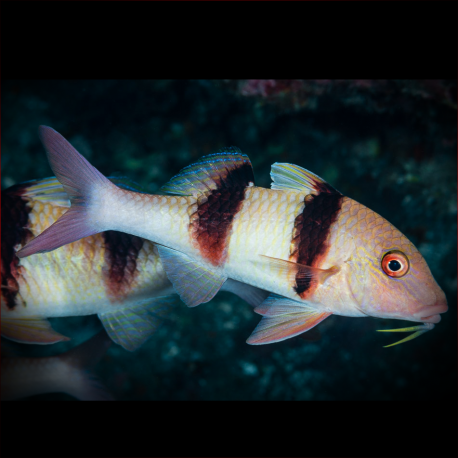More info
Datasheet
| Minimum Tank Size | 800 litres / 211.34 US gallons |
| Maximum Size | 35.0cm / 13.78inches |
| Reef Compatible | Reef safe with caution |
| Temperament | Docile |
| Temperature | 22.2°C / 71.96°F - 25.6°C / 78.08°F |
| Specific Gravity | 1.020-1.025 |
| Carbonate Hardness | 8-12 |
| pH | 8.1-8.4 |
General Description
The Doublebar goatfish, scientifically known as Parupeneus trifasciatus, is a member of the Mullidae family, characterized by their distinctive "beard" used for foraging in the sand. This species belongs to the Parupeneus trifasciatus complex, encompassing various goatfish species found in regions such as the Indian Ocean, eastern Indian Ocean, and the western Pacific.
Aquarium Suitability
The Doublebar goatfish is not particularly well-suited for aquarium life, often facing challenges like malnutrition leading to early demise. Proper care demands a varied diet consisting of 4-5 feedings daily in addition to allowing the fish to scavenge for food in the tank. This species can be a threat to smaller fish, crustaceans, and invertebrates, making it essential to house it with caution.
Demands, Care, and Hardiness
With an average hardiness level, this docile species thrives best when provided with ample hiding spots, such as gaps between live rocks, and a spacious aquarium environment to facilitate its swimming habits. Maintaining a stable tank environment with appropriate water conditions, including a pH of 8.1-8.4, a temperature range of 22.2-25.6°C, a salinity of 1.020-1.025, and a carbonate hardness of 8-12 dKH, is crucial for the well-being of the Doublebar goatfish.
Reef Suitability
Considered reef-safe with caution, this goatfish should be monitored closely in reef setups due to its predatory nature towards small fish and crustaceans. Adequate provisions must be made to ensure the safety of other tank inhabitants in a reef environment.
Aquarium Setup
Creating a suitable aquarium setup for the Doublebar goatfish involves providing a large open area with a substrate mix of sand and coral gravel, mimicking its natural habitat. Incorporating live rocks for hiding and exploration enhances the overall well-being of this shy species in captivity.
Behaviour
Known for its shy and docile temperament, the Doublebar goatfish can exhibit jumping behavior when housed in open-top aquariums. This species is inclined to sift through sand in search of food, which may contribute to cloudiness in the water and disturb detritus within the tank.
Feeding and Diet
The recommended diet for the Doublebar goatfish includes a variety of food sources such as fish, larger crustaceans, small crustaceans, other invertebrates, and zooplankton. Frequent feeding sessions throughout the day are necessary, especially for juvenile individuals, until they adapt to scavenging in the aquarium for natural food sources.
Habitat and Distribution
In the wild, the Doublebar goatfish can be found in the East Indian Ocean, West Indian Ocean, and Indonesia, inhabiting sandy bottoms and coral reefs. Understanding its natural habitat and distribution plays a pivotal role in replicating a suitable environment within an aquarium setting for the well-being of this species.

